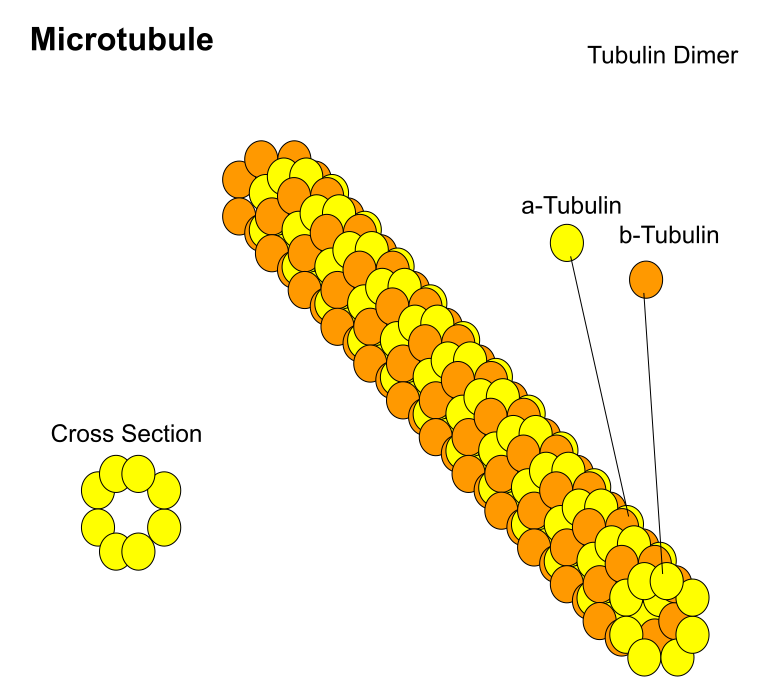
Microtubules are constituents of
A) Centrosome, nucleosome, and centrioles
B) Cilia, flagella and peroxisomes
C) Spindle fibers, centrioles and cilia
D) Centrioles, spindle fibers and chromatin
Answer
453.6k+ views
Hint: Microtubules are hollow cylinders with diameter approximately equal to 25nm and they vary in length from 200 nanometer to 25 micrometers. The lateral association between 12 and 17 protofilaments into a regular helical lattice is the reason behind the formation of them.
Complete answer:
Microtubules are the un-branched hollow submicroscopic tubules of protein tubulin and they develop on specific nucleating regions. It can undergo quick dissolution or growth at their ends by disassembly or assembly of monomers. Microtubules occur widely in eukaryotic cells except in Slime Moulds and Amoebae. They are present in cytoplasm as well as in the specialized structures like basal bodies, cilia or flagella, centrioles, spindle fibres, chromosome fibres, sensory hair, equatorial ring of thrombocytes etc. And they are responsible for the cell movement.
Spindle fibers form the protein structure which helps in meiosis and mitosis. The cell organelle called centrosome has two two cylindrical structures known as Centrioles. Flagella and Cilia are fine hair-like outgrowths of the membrane, but peroxisomes are the microbodies.

Hence, the correct answer is option (C).
Note: A microtubule may appear to be completely stable under steady state, however there is action taking place constantly. Populations of microtubules usually consist of some that are growing and some that are shrinking. A single microtubule can oscillate between shortening and growth phases. During its growth phase, heterodimers are added on to the end of a microtubule, and during the shrinkage phase they come off as intact subunits.
Complete answer:
Microtubules are the un-branched hollow submicroscopic tubules of protein tubulin and they develop on specific nucleating regions. It can undergo quick dissolution or growth at their ends by disassembly or assembly of monomers. Microtubules occur widely in eukaryotic cells except in Slime Moulds and Amoebae. They are present in cytoplasm as well as in the specialized structures like basal bodies, cilia or flagella, centrioles, spindle fibres, chromosome fibres, sensory hair, equatorial ring of thrombocytes etc. And they are responsible for the cell movement.
Spindle fibers form the protein structure which helps in meiosis and mitosis. The cell organelle called centrosome has two two cylindrical structures known as Centrioles. Flagella and Cilia are fine hair-like outgrowths of the membrane, but peroxisomes are the microbodies.

Hence, the correct answer is option (C).
Note: A microtubule may appear to be completely stable under steady state, however there is action taking place constantly. Populations of microtubules usually consist of some that are growing and some that are shrinking. A single microtubule can oscillate between shortening and growth phases. During its growth phase, heterodimers are added on to the end of a microtubule, and during the shrinkage phase they come off as intact subunits.
Recently Updated Pages
Glucose when reduced with HI and red Phosphorus gives class 11 chemistry CBSE

The highest possible oxidation states of Uranium and class 11 chemistry CBSE

Find the value of x if the mode of the following data class 11 maths CBSE

Which of the following can be used in the Friedel Crafts class 11 chemistry CBSE

A sphere of mass 40 kg is attracted by a second sphere class 11 physics CBSE

Statement I Reactivity of aluminium decreases when class 11 chemistry CBSE

Trending doubts
The reservoir of dam is called Govind Sagar A Jayakwadi class 11 social science CBSE

10 examples of friction in our daily life

Difference Between Prokaryotic Cells and Eukaryotic Cells

State and prove Bernoullis theorem class 11 physics CBSE

Proton was discovered by A Thomson B Rutherford C Chadwick class 11 chemistry CBSE

State the laws of reflection of light




